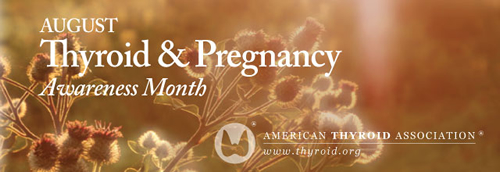
Clinical Thyroidology for the Public summarizes selected research studies discussed in the previous month’s issue of Clinical Thyroidology, an official publication of the American Thyroid Association. Editor-in-chief, Alan Farwell, MD, FACE
Available in pdf format for saving and printing and Web page format for viewing online
PDF Format for Saving and Printing
Clinical Thyroidology for the Public Volume 14 Issue 8 (PDF file, 4.91 MB)
TABLE OF CONTENTS – Web Format
GRAVES’ DISEASE
Age and sex predict severity, remission, and recurrence in Graves’ disease
Graves’s disease can be treated with antithryoid medications with the goal of causing the Graves’ disease to go into remission, allowing the medications to be stopped and the thyroid function to return to normal. Identifying clinical factors that may predict remission with medications can help guide doctors and patients when deciding on the most appropriate therapy for each individual. This study was done to investigate how age and sex of patients affect the severity of the Graves’ disease, the chances of achieving remission and the risk of recurrence once treatment is stopped.
Suzuki N et al. Does Age or Sex Relate to Severity or Treatment Prognosis in Graves’ Disease? Thyroid Epub 2021 Apr 21. PMID: 33882721.
GRAVES’ DISEASE
Risk factors for the development of thyroid eye disease in patients with Graves’ disease
Up to 50% of patients with Graves’ disease develop thyroid eye disease (TED). Moderate to severe TED is very serious and can significantly affect the appearance of the eyes and cause loss of vision. This study was performed to see if there were risk factors associated with TED and, in particular, with progression to severe TED.
Lee, M et al 2020 Risk factors of thyroid eye disease. Endocr Pract 27:245–253. PMID: 33655885
THYROID CANCER
Do surgeons support lobectomy for low-risk papillary thyroid cancer?
Given the excellent prognosis of thyroid cancer, in recent years,
thyroid experts, high volume thyroid surgeons and national
guidelines have recommended doing a lobectomy as opposed
to a total thyroidectomy for low risk thyroid cancers. The
authors of the study surveyed surgeons across the country
that had performed thyroid surgery in recent years to examine
their attitudes and performance of type of surgery for low risk
thyroid cancer.
McDow AD et al 2021 Thyroid lobectomy for low-risk papillary thyroid cancer: A national survey of low- and high-volume surgeons. Ann Surg Oncol.
THYROID CANCER
Initiation of thyroid hormone therapy is common following thyroid lobectomy for low risk thyroid cancer
Many patients with low risk thyroid cancer do fine after only a lobectomy. One advantage of a thyroid lobectomy is the possibility the patient will not need lifelong thyroid hormone therapy. However, after a lobectomy for thyroid cancer, thyroid hormone therapy may be indicated even if the TSH level is in the normal range. This study was performed to see how often patients who had a lobectomy for low-risk thyroid cancer needed thyroid hormone after the surgery.
Schumm MA et al. 2021 Frequency of thyroid hormone replacement after lobectomy for differentiated thyroid cancer.
THYROID CANCER
Competing Risks of Death in Older Thyroid Cancer Patients
Most types of thyroid cancer have an excellent prognosis, with a 10 year survival of 85-90%. Thus, most thyroid cancer patients die of other causes and not related to the thyroid cancer. The objective of this study was to determine whether older adults with thyroid cancer are more likely to die from thyroid cancer or other diseases, and determine factors associated with each.
Papaleontiou M et al. 2021 Competing causes of death in older adults with thyroid cancer. Thyroid. Epub 2021 Mar 25. PMID: 33764188.
THYROID NODULES
An evaluation of the management of thyroid nodules in children
While thyroid nodules are uncommon in children, they have a higher rate of cancer than in adults. The ATA developed guidelines in 2015 for the management of childhood thyroid nodules. The purpose of this study is to analyze the management of thyroid nodules in children and understand the clinical practice variations or differences when comparing clinical practices to the 2015 ATA guidelines.
Al Maawali A et al 2020 The thyroid nodules in kids study (ThyNK study): An evaluation of clinical practice variation. J Pediatr Surg 55:950–953. PMID: 32081357.



